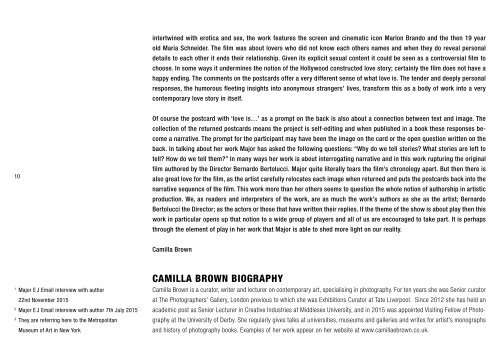PLAYING AND REALITY
FF_EJ_Major_RZ
FF_EJ_Major_RZ
You also want an ePaper? Increase the reach of your titles
YUMPU automatically turns print PDFs into web optimized ePapers that Google loves.
intertwined with erotica and sex, the work features the screen and cinematic icon Marlon Brando and the then 19 year<br />
old Maria Schneider. The film was about lovers who did not know each others names and when they do reveal personal<br />
details to each other it ends their relationship. Given its explicit sexual content it could be seen as a controversial film to<br />
choose. In some ways it undermines the notion of the Hollywood constructed love story; certainly the film does not have a<br />
happy ending. The comments on the postcards offer a very different sense of what love is. The tender and deeply personal<br />
responses, the humorous fleeting insights into anonymous strangers’ lives, transform this as a body of work into a very<br />
contemporary love story in itself.<br />
10<br />
Of course the postcard with ‘love is…’ as a prompt on the back is also about a connection between text and image. The<br />
collection of the returned postcards means the project is self-editing and when published in a book these responses become<br />
a narrative. The prompt for the participant may have been the image on the card or the open question written on the<br />
back. In talking about her work Major has asked the following questions: “Why do we tell stories? What stories are left to<br />
tell? How do we tell them?” In many ways her work is about interrogating narrative and in this work rupturing the original<br />
film authored by the Director Bernardo Bertolucci. Major quite literally tears the film’s chronology apart. But then there is<br />
also great love for the film, as the artist carefully relocates each image when returned and puts the postcards back into the<br />
narrative sequence of the film. This work more than her others seems to question the whole notion of authorship in artistic<br />
production. We, as readers and interpreters of the work, are as much the work’s authors as she as the artist; Bernardo<br />
Bertolucci the Director; as the actors or those that have written their replies. If the theme of the show is about play then this<br />
work in particular opens up that notion to a wide group of players and all of us are encouraged to take part. It is perhaps<br />
through the element of play in her work that Major is able to shed more light on our reality.<br />
11<br />
Camilla Brown<br />
1<br />
Major E J Email interview with author<br />
22nd November 2015<br />
2<br />
Major E J Email interview with author 7th July 2015<br />
3<br />
They are referring here to the Metropolitan<br />
Museum of Art in New York<br />
CAMILLA BROWN BIOGRAPHY<br />
Camilla Brown is a curator, writer and lecturer on contemporary art, specialising in photography. For ten years she was Senior curator<br />
at The Photographers’ Gallery, London previous to which she was Exhibitions Curator at Tate Liverpool. Since 2012 she has held an<br />
academic post as Senior Lecturer in Creative Industries at Middlesex University, and in 2015 was appointed Visiting Fellow of Photography<br />
at the University of Derby. She regularly gives talks at universities, museums and galleries and writes for artist’s monographs<br />
and history of photography books. Examples of her work appear on her website at www.camillaebrown.co.uk.


